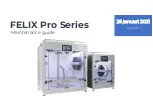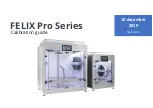
RESTRICTED USE ONLY
Fargo Electronics, Inc.
HDP600 High Definition Card Printer/Encoder User Guide (Rev. 2.5)
7-8
Conducting the Tape adhesion Test (continued)
Step Procedure
4
Visually examine the card and the strip of tape pulled from the card, to see if
any portion of the HDP Film was removed from the card.
•
If any residue (e.g., oil or grease from fingertips) is present on the card
surface, the evaluation results may be affected.
•
If the printed, transferred HDP Film particles (a) pull away from the card
and (b) adhere to the tape, this indicates that inadequate adhesion of the
HDP Film to the card. Increased heat and Dwell Times are necessary to
resolve this problem.
Samples 1, 2 and 3 show a representation of the adhesion level you can
expect.
•
Result 1:
Sample 1 shows a significant transfer to the tape and is an
absolute failure.
•
Result 2:
Sample 2 shows that very slight transfer to the tape can be
acceptable without sacrificing overall image durability on matte finish cards.
•
Result 3:
Sample 3 shows no transfer to the Tape and is an Absolute
Pass.
5
If the tape test indicates inadequate adhesion, increase the heat setting by 5
degrees, print another card and try the tape test again.
•
Once the temperature has been increased 4 times (20 degrees), reset
temperature to default and increase the Dwell Time by .5 second.
•
Repeat this process until adequate adhesion is achieved.
•
Use the YMCKH Ribbon if printing to a matte-surfaced card. (
Note:
This
Ribbon provides a Heat Seal Panel that allows for improved adhesion to
non-glossy PVC surfaces.)
•
Ensure that the cards (in use) have a surface roughness (Ra) of 60 micro
inches or less.
This information should be available from the card manufacturer.
















































